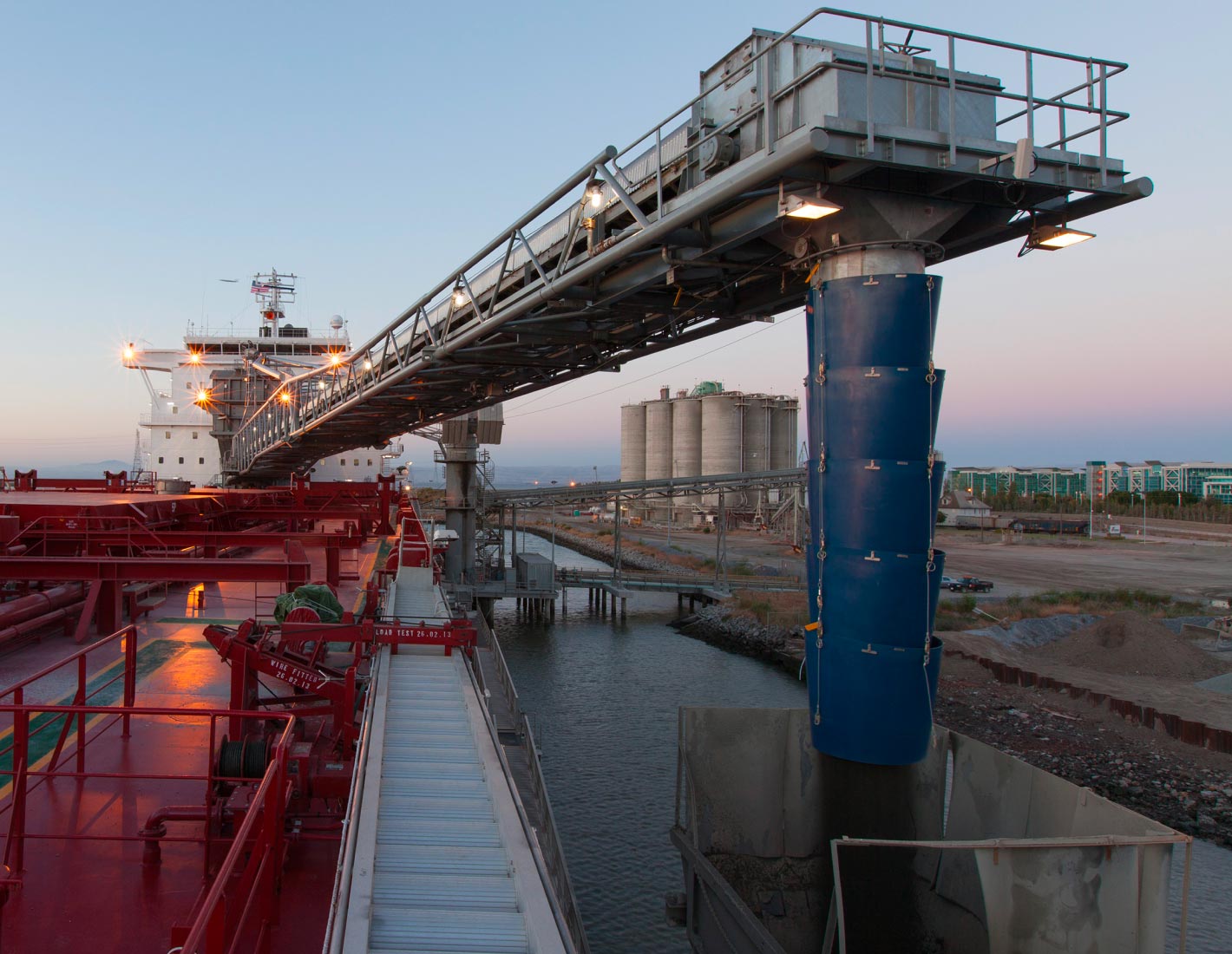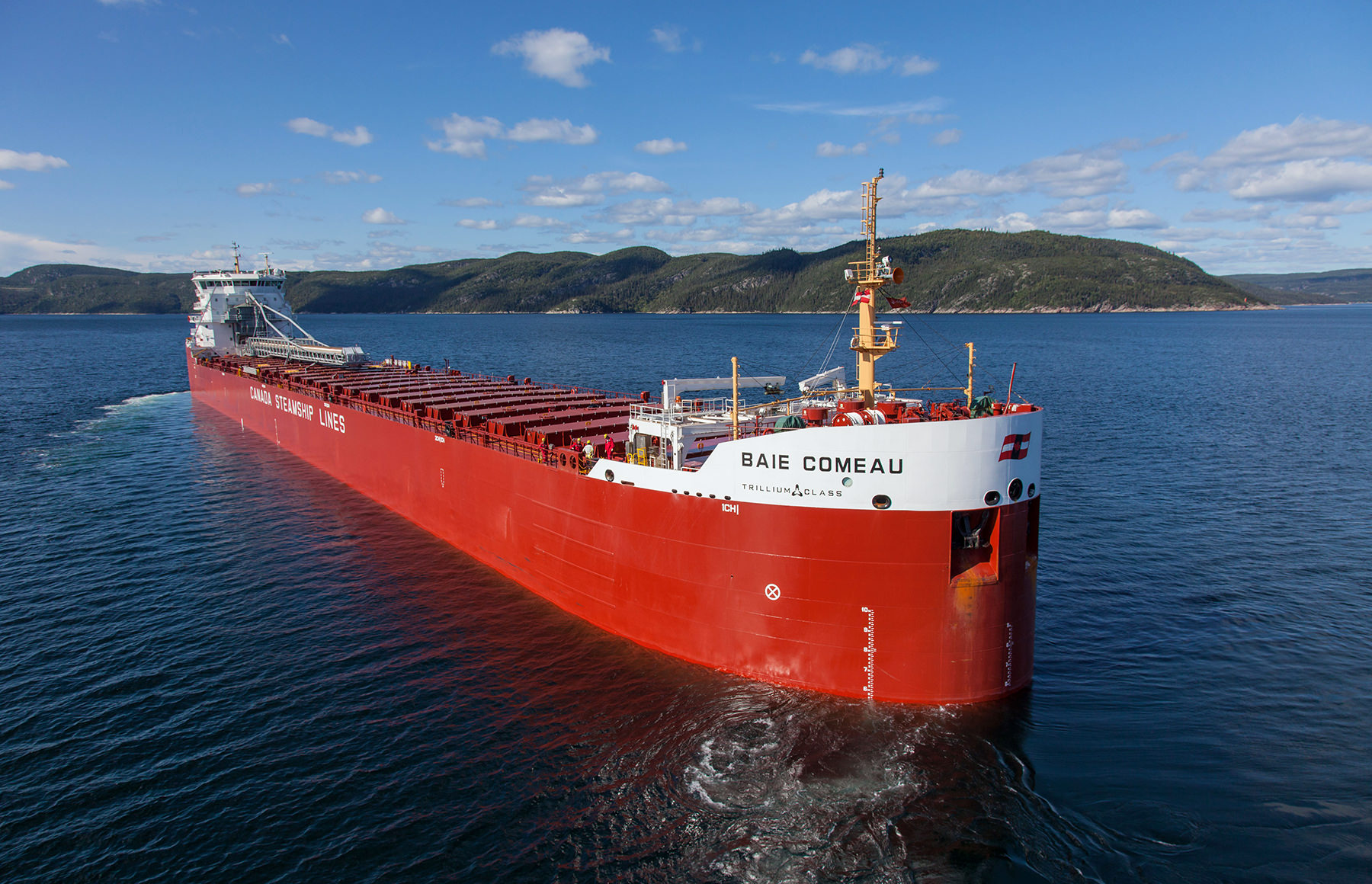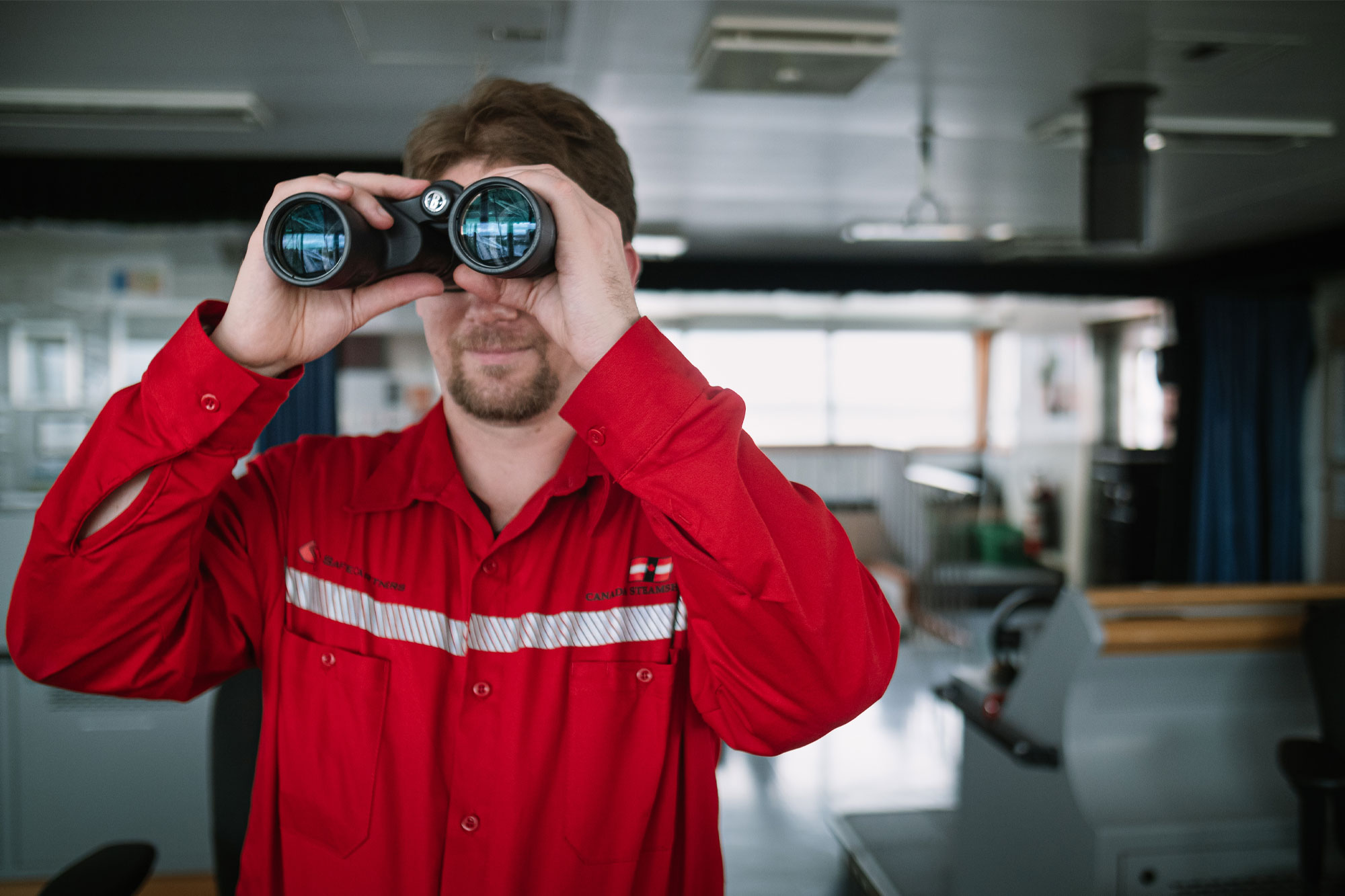
Our Murals
The Sea Keeper
Between mid-February and early March of 2017, four urban Montreal artists worked together to create the mural on the forward façade of the accommodations block of the bulk carrier CSL St-Laurent that depicts a Canada goose with its powerful wings spread in flight, its forward motion a tribute to Montreal and to Canada.
The Sea Keeper/Gardien des eaux is an original work of art conceived by Montreal urban artist Bryan Beyung and created by Beyung with artists FONKi, Ankh One, and Benny Wilding of the Ashop art collective. The monumental mural was created over a few weeks – a feat which in itself is worth noting – and required the ingenuity of CSL’s Technical Team to make it a success. Painting an original work-of-art of this scale on a ship was a first for the artists, a first for CSL and a first for a Canadian commercial vessel.
Back story
From the entrance way at the Ile d’Anticosti, to the head of Lake Superior, tens of thousands of the great Canada Geese feed and nest along the 3,700-km waterway. On cool grey mornings and against the backdrop of neon sunsets, seafarers on the decks of Canada Steamship Lines (CSL)’s cargo ships marvel as the geese rise into the skies in flocks that migrate south in their emblematic V-shaped formations.

Between mid-February and early March of 2017, four urban Montreal artists worked together to create the mural on the forward façade of the accomodations block of the bulk carrier CSL St-Laurent that depicts a Canada goose with its powerful wings spread in flight, its forward motion a tribute to Montreal and to Canada.
The Sea Keeper/Gardien des eaux is an original work of art conceived by Montreal urban artist Bryan Beyung and created by Beyung with artists FONKi, Ankh One, and Benny Wilding of the Ashop art collective. The monumental mural was created over a few weeks – a feat which is in itself is worth noting – and required the ingenuity of CSL’s Technical Team to make it a success. Painting an original work-of-art of this scale of a a ship was a first for the artists, a first for CSL and a first for a Canadian commercial vessel.
Instantly recognizable, the iconic Canada Goose is a familiar sight along the banks of the St. Lawrence Seaway and represents the vessel sailing in harmony with nature. It was natural, then, that the bird in flight would be depicted on the CSL-commissioned mural to commemorate Canada’s 150th birthday, the 375th anniversary of the City of Montreal, and the roles of the St. Lawrence Seaway, marine transport, and CSL itself in building the nation and the City.
Clearly visible from afar, the goose’s coherent outline contains its diverse and colourful back, wings and tail, each painted by one of the four artists in his signature style and with his unique vision.
Bursting with colour, The Sea Keeper melds and weaves the diverse techniques of each artist into a unique and beautiful piece of art that combines cultures and styles to evoke Montreal’s and Canada’s diversity. The mural’s overall impact is both inspiring and hopeful to the seafarers who will sail with it everyday and to the thousands of people on the shores of the Great Lakes and St-Lawrence River who will watch it as CSL St-Laurent and her Sea Keeper sail by.
CSL chose CSL St-Laurent to host the tribute to Montreal and Canada because her name honours the St. Lawrence River, and her state-of-the-art technology and seamanship represent the new generation of high-performing, environmentally-responsible cargo vessels.
For CSL, the mural project also highlights the renewal under way at CSL with Louis Martel officially stepping into the role of President and CEO of CSL Group on April 1. Under his leadership, CSL is focused on the future with a new structure and team that is ready for both the challenges and the opportunities that lie ahead. Like the Sea Keeper, CSL’s vision for the future is one of diversity, collaboration, innovation and excellence.
Producing an original work of art of this size on a cargo vessel was not only a first for the artists and the company, it is a first for a Canadian commercial bulker.
The history of marine transportation in nation and city building goes back a long way. Long before what is now Canada existed, First Nations’ explorers and entrepreneurs paddled freighter canoes the length of the continent’s waterways, trading furs, tools, beads and food. Later, Métis and First Nations voyageurs working for the Hudson’s Bay Company transported goods and supplies via what is now the St. Lawrence Seaway, opening up huge swathes of land and leading the way for the barges, ferries, freighters, tugboats and ships that have put marine transportation at the heart of Canada’s and Montreal’s economy and history.
Not only has the shipping industry served as a lifeline to businesses and communities along the Seaway, it has created jobs that have sustained Canadian and Montreal families for more than 100 years. Today the St. Lawrence Seaway is a dynamic and vital trade artery connecting the North American heartland to overseas markets. Since it’s monumental completion in 1959, ships transiting the Seaway’s locks have carried 2.9 billion tonnes of cargo valued at more than $400 billion safely and efficiently.
CSL St-Laurent is the second Great Lakes bulk carrier of Canada Steamship Lines’ Trillium Class. The vessel’s arrival in the Port of Montreal on February 15, 2015, marked the final step in the Trillium Class newbuild program that produced a total of 11 state-of-the-art self-unloaders and bulk carriers for CSL’s Canadian and Americas fleets.
Like all Trillium Class vessels, CSL St-Laurent features the latest engine technology and hull design to increase fuel efficiency and decrease air emissions, double hulls to prevent spills in the event of an accident as well as state-of-the-art cargo handling systems to minimize dust and cargo residue.
What is the Trillium Class?
The Trillium Class is the name of CSL’s latest-generation fleet consisting of four new self-unloading Lakers and two new bulk carriers operating on the Great Lakes and St. Lawrence River, and five new Panamax self-unloaders operating on the coasts of the Americas.
Trillium Class ships offer exceptional value, speed, versatility and efficiency. CSL St-Laurent and her sister ship, CSL Welland are equipped with IMO Tier II compliant main engines as well as the latest environmental and safety technologies, and operate under the same high standards of operational efficiency and reliability set by CSL’s Trillium Class self-unloading vessels.
Photos
Artists

Bryan Beyung
Bryan Beyung was born in Montreal in a refugee family. The blend of cultures in which he grew up influenced his art with a will of self-determination. With a Bachelor’s degree in graphic design, Beyung is well aware of the infinite possibilities digital technologies present. However, he is weary of their mechanistic nature, preferring more intuitive methods that allow for a deeper sense of abstract art – an influence that is rooted in his past as a graffiti artist. Beyung creates unstructured and dynamic compositions where the concept of freedom of expression meets technical precision. Between figurative and abstract art, he fills an empty space with a burst of color and graphic design. The strength of his work lies is in this constant duality.
– Marie-Ève Tanguay, Atelier Marcel Barbeau, Art Historian

Fonki
Montreal urban artist FONKi was born in France of Cambodian parents who fled the Khmer Rouge genocide in the 70s. He discovered grafitti at 15 years old and became a leading figure in the city’s new generation of graffiti artists. FONKi’s murals span the globe with works in France, Cambodia, Belgium, England, Mexico, Vietnam and the United States. Everywhere he goes, he paints giant portraits depicting local people. These anonymous faces have become FONKi’s signature. FONKi is the main character of documentary entitled “The Roots Remain” that features his return to Cambodia. He discovers a country in transition and creates the very first “kbach” style graffiti lettering – a mix of modern and traditional Cambodian art found on the hundred-year-old frescoes of Angkor temples.

Benny Wilding
Benny Wilding discovers his love for the arts for the first time in New York, at the age of 12, in the middle of the ’90s. Highly impressed by the painted walls criss-crossing the city that never sleeps, he returns to Montreal with the desire to shine in this new graffiti culture. Pursuing his new passion in all of its aspects, within his city and its surroundings, today he is more and more interested in aesthetic and artistic approaches to street art. From the first day since he started using spray paint, his passion has been fuelled by artistic development, as well as his own environment and lifestyle.

Ankh One
In the early 90s, Ankh started doing graffiti on the walls of his native city of Grenoble, France. It is this mode of expression that led him to the benches of the École Superieure d’Art Appliqué in Troyes. In 2001 he joined the reputed Parisian collective, 9e Concept and was also art director for Graff-It magazine as well as for the fragrance brand Confinluxe. In 2013, Ankh moved to Montreal where he joined the A’Shop art collective. Well versed in graphic design, illustration and painting, he uses all these mediums to represent what he calls “poetry in motion”.














